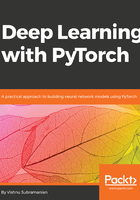
What this book covers
Chapter 1, Getting Started with Deep Learning Using PyTorch, goes over the history of artificial intelligence (AI) and machine learning and looks at the recent growth of deep learning. We will also cover how various improvements in hardware and algorithms triggered huge success in the implementation of deep learning across different applications. Finally, we will introduce the beautiful PyTorch Python library, built on top of Torch by Facebook.
Chapter 2, Building Blocks of Neural Networks, discusses the knowledge of various building blocks of PyTorch, such as variables, tensors, and nn.module, and how they are used to develop neural networks.
Chapter 3, Diving Deep into Neural Networks, covers the different processes involved in training a neural network, such as the data preparation, data loaders for batching tensors, the torch.nn package for creating network architectures and the use of PyTorch loss functions and optimizers.
Chapter 4, Fundamentals of Machine Learning, covers different types of machine learning problems, along with challenges such as overfitting and underfitting. We also cover different techniques such as data augmentation, adding dropouts, and using batch normalization to prevent overfitting.
Chapter 5, Deep Learning for Computer Vision, explains the building blocks of Convolutional Neural Networks (CNNs), such as one-dimensional and two-dimensional convolutions, max pooling, average pooling, basic CNN architectures, transfer learning, and using pre-convoluted features to train faster.
Chapter 6, Deep Learning with Sequence Data and Text, covers word embeddings, how to use pretrained embeddings, RNN, LSTM, and one-dimensional convolutions for text classification on the IMDB dataset.
Chapter 7, Generative Networks, explains how to use deep learning to generate artistic images, new images with DCGAN, and text using language modeling.
Chapter 8, Modern Network Architectures, explores architectures such as ResNet, Inception, and DenseNet that power modern computer vision applications. We will have a quick introduction to encoder-decoder architectures that power modern systems such as language translations and image captioning.
Chapter 9, What Next?, looks into the summarizes what we have learned and looks at keeping yourself updated in the field of deep learning.